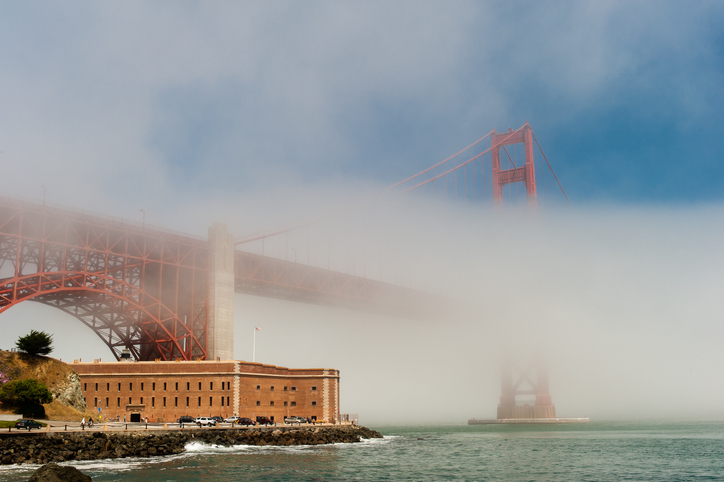Fort Point: A Brief History

A Civil War-era fortress tucked near the southern anchorage of the Golden Gate Bridge, Fort Point was originally slated to be removed in the original Bridge plans.
An attempt in 1926 to preserve the fort by the American Institute of Architects failed to gain traction, but Chief Engineer Joseph Strauss recognized its historic value. “While the old fort has no military value now,” Strauss wrote, “it remains nevertheless a fine example of the mason’s art… it should be preserved and restored as a national monument.”
In response to this challenge, Strauss’ engineers fashioned a massive steel arch that supported the roadway while preserving the fort. This design element—a graceful arc in elegant juxtaposition to the angular brick structure below—saved Fort Point, which would be named a National Historic Site by Richard Nixon on October 16, 1970. (There is some disagreement as to who came up with the arch design; one reference says it was Clifford E. Paine, another credits Charles A. Ellis.)
Construction
With California attaining statehood in 1850, U.S. military officials called for improved defenses around the San Francisco Bay. The U.S. Army Corps of Engineers began work on Fort Point in 1853, and Inspector General Joseph F.K. Mansfield declared the fort’s strategic position as “the key to the whole Pacific Coast.”
The fort was modeled on the classic “Third System” design formulated in the aftermath of the War of 1812 to secure America’s harbors, and exemplified most famously by Fort Sumter. Featuring characteristic seven-foot-thick walls and three tiers of casemates (vaulted rooms), Fort Point would be the only Third System fort built on the West Coast.
A crew of 200, many of them failed gold miners, labored for eight years on Fort Point. A foundation of granite—shipped from China—was laid, as were eight million bricks made in a nearby brickyard. During construction, one admiring reporter marveled at the “solid masonry of more than ordinary artistic skill” and declared that the fortress would be “the admiration and pride of the Pacific.”
During the Civil War
The mighty fortress was completed in 1861, on the eve of the Civil War. As many as 500 men were garrisoned at Fort Point during the war, spending their days in a monotonous cycle of drills, inspections, and severe cold.
Fort Point was never mounted with its full complement of 141 cannons (in October 1861 there were 69 guns), and it never saw any action during the Civil War. The CSS Shenandoah was on its way to attack San Francisco when the captain learned that the war was over. It was August 1865.
In the Aftermath of the Civil War
Severe damage suffered by Third System forts such as Fort Sumter made it clear: the heyday of fortifications like Fort Point was over. New military technologies—especially rifled artillery—rendered the masonry walls useless and the fort defenseless.
After the Civil War, Fort Point was virtually abandoned. The Army periodically updated the structure, but the fort was never again continuously occupied. Fort Point suffered moderate damage during the 1906 earthquake and was used sporadically for housing, training, or storage. During World War II, soldiers were stationed at Fort Point to guard the minefields and anti-submarine net across the Golden Gate.
Fort Point Today
Named a National Historic Site in 1970, Fort Point is now part of the Golden Gate National Parks, a unit of the National Park Service (see www.nps.gov/goga for information). Visitors can tour the “Gibraltar of the West” Friday through Sunday, 10:00 a.m. to 5:00 p.m., and enjoy unique views of the Golden Gate Bridge and its impressive Fort Point Arch that saved the old fortress from demolition.
The American Civil War Association holds Civil War reenactments and commemorations throughout the year. Additional events—including candlelight tours—can be found at https://www.parksconservancy.org/events.